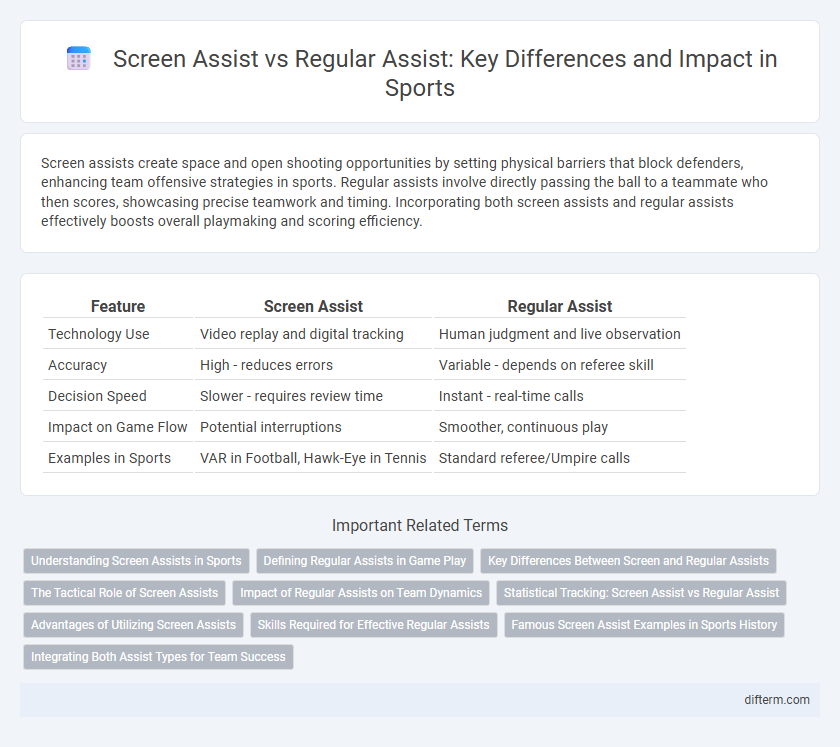Screen assists create space and open shooting opportunities by setting physical barriers that block defenders, enhancing team offensive strategies in sports. Regular assists involve directly passing the ball to a teammate who then scores, showcasing precise teamwork and timing. Incorporating both screen assists and regular assists effectively boosts overall playmaking and scoring efficiency.
Table of Comparison
| Feature | Screen Assist | Regular Assist |
|---|---|---|
| Technology Use | Video replay and digital tracking | Human judgment and live observation |
| Accuracy | High - reduces errors | Variable - depends on referee skill |
| Decision Speed | Slower - requires review time | Instant - real-time calls |
| Impact on Game Flow | Potential interruptions | Smoother, continuous play |
| Examples in Sports | VAR in Football, Hawk-Eye in Tennis | Standard referee/Umpire calls |
Understanding Screen Assists in Sports
Screen assists in sports involve a strategic play where a player sets a physical barrier to block defenders, creating space for teammates to execute passes or shots, differing from regular assists that simply credit the last pass before a score. This tactic is prominent in basketball and hockey, enhancing offensive opportunities by disrupting defensive alignments. Understanding screen assists requires recognizing the value of teamwork and spatial positioning essential for successful plays and scoring.
Defining Regular Assists in Game Play
Regular assists in gameplay occur when a player directly passes the ball to a teammate who then scores without any interference or deflection. This statistical measure is crucial in evaluating a player's contribution to offensive plays, highlighting their ability to create scoring opportunities. Unlike screen assists, regular assists do not involve indirect passes or multiple player interactions before the goal.
Key Differences Between Screen and Regular Assists
Screen assists in sports involve a player setting a physical barrier to block an opponent, enabling a teammate to advance or score, while regular assists are directly linked to the pass preceding a successful shot or play. The key difference lies in screen assists impacting player movement and positioning strategy, whereas regular assists quantify direct contribution to scoring. Understanding these distinctions enhances tactical gameplay analysis and player performance metrics.
The Tactical Role of Screen Assists
Screen assists create space for shooters by setting tactical picks that divert defenders, enhancing team offensive flow. Unlike regular assists that directly lead to a score, screen assists are critical in manipulating defensive schemes and enabling effective shot opportunities. This strategic role increases the efficiency of team play by disrupting defensive rhythm and opening clearer lines for scoring.
Impact of Regular Assists on Team Dynamics
Regular assists in sports significantly enhance team dynamics by fostering seamless communication and coordinated play, which boosts overall performance and morale. These assists encourage players to anticipate each other's movements, leading to more fluid and strategic gameplay. Consistent execution of regular assists strengthens trust among teammates and creates a more cohesive unit capable of adapting to opponents' strategies.
Statistical Tracking: Screen Assist vs Regular Assist
Statistical tracking differentiates screen assists from regular assists by evaluating the specific actions leading to a scoring opportunity; screen assists credit the player who made the pass prior to the assist pass, often reflecting a higher level of playmaking involvement. Screen assists capture a player's ability to influence plays beyond just the final pass, providing a deeper analysis of court vision and teamwork in sports like basketball and hockey. Regular assists primarily measure the direct pass that leads to a score, while screen assists offer a more granular insight into momentum-building sequences and player contributions.
Advantages of Utilizing Screen Assists
Screen assists create space and open lanes by effectively blocking defenders, enabling teammates to receive passes and take uncontested shots. They increase scoring opportunities through enhanced ball movement and player positioning compared to regular assists. Utilizing screen assists also improves team coordination and offensive efficiency by disrupting defensive schemes and facilitating strategic plays.
Skills Required for Effective Regular Assists
Effective regular assists in sports demand precise spatial awareness, quick decision-making, and accurate passing skills to create scoring opportunities. Players must master ball control, anticipate teammates' movements, and maintain strong communication to execute timely and strategic assists. These skills differentiate regular assists from screen assists, which primarily rely on physical positioning and setting screens rather than direct ball distribution.
Famous Screen Assist Examples in Sports History
The screen assist in sports involves a player setting a strategic block to free a teammate for an unobstructed shot, famously executed by Steve Nash's iconic pick-and-roll plays in NBA history. Unlike regular assists that simply involve passing the ball leading to a score, screen assists emphasize creating scoring opportunities through tactical positioning and screens. Michael Jordan's collaboration with Scottie Pippen showcases effective screen assists that revolutionized offensive teamwork in basketball.
Integrating Both Assist Types for Team Success
Integrating screen assists and regular assists enhances team performance by increasing scoring opportunities and diversifying offensive strategies. Screen assists create space and open shots for teammates, while regular assists directly contribute to successful passes leading to points. Combining these assist types improves ball movement, player positioning, and overall offensive efficiency in competitive sports.
screen assist vs regular assist Infographic

 difterm.com
difterm.com